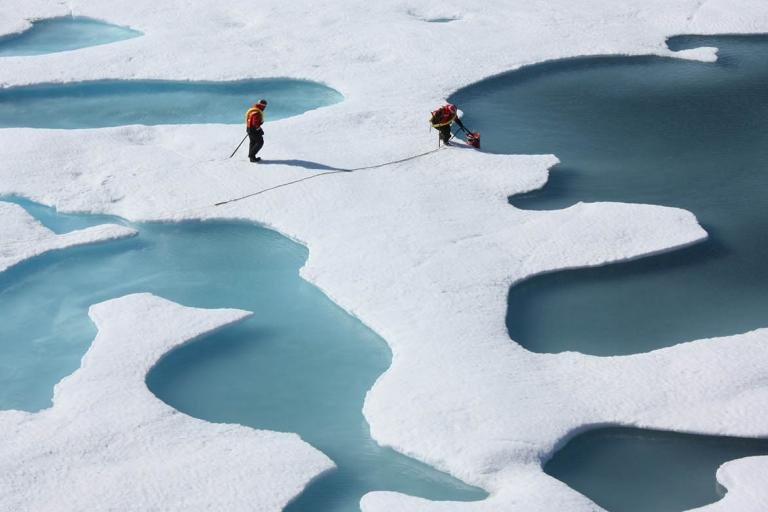Scientists sample meltwater among the Arctic sea ice. Photo by NASA/Goddard Space Flight Center
Jan. 16 (UPI) -- New research suggests weather anomalies are to blame for intense periods of accelerating Arctic sea ice loss.
While research has confirmed links between global warming, rising Arctic temperatures and ongoing sea ice loss, variability remains. A pair of new studies conducted by Swiss scientists suggests unusual weather patterns account for the variability.
Most recently, researchers were able to show a strong link between high pressure systems and accelerated ice melting during the summers of 2007 and 2012.
While summer sea ice minimums in the Arctic have been on the general decline for several decades, 2007 and 2012 featured extreme melting. Scientists have struggled to account for the outliers
When scientists compared regional weather patterns with periods of accelerated melting during the two summers, they found low pressure systems over the North Atlantic and North Pacific triggered the injection of air masses into the Arctic atmosphere. The injections raised the height of the tropopause, the boundary layer separating the troposphere and stratosphere. The influx of air caused high pressure systems to develop below, causing several days of cloudless skies.
The unusual weather allowed solar radiation to melt the sea ice nonstop for nearly two weeks. During the studied periods of high pressure, sea ice receded and thinned at accelerated rates.
"The level of solar radiation is the main factor in the melting of the ice in summer," Heini Wernli, an atmospheric scientist at ETH Zurich, said in a news release.
Wernli and his colleagues published their findings this week in the journal Nature Geoscience.
Wernli also led an investigation of melting during a recent Arctic winter. In winter, Arctic sea ice grows. Its size is a product of the previous summer's melting rates and growth rates during the winter.
But in the winter of 2015 and 2016, at the end of December, temperatures rose above freezing for several days. Scientists determined that a rare combination of air currents delivered unusually warm air to the region. One of the air masses was heated by compression, while another was heated by the warmth of the ocean. A third air mass delivered already warm, surface-level air from the Sahara.
"It's extremely rare for warm, near-surface subtropical air to be transported as far as the Arctic," said Hanin Binder, a doctoral student at ETH Zurich.
A unique pattern of high and low pressure systems among the middle latitudes created unique atmospheric highway systems, funneling the air masses toward the Arctic at high speeds.
"These weather conditions and their effect on the sea ice were really exceptional," said Binder.
While scientists say global warming is to blame for longterm melting trends in the Arctic, it's not clear what role climate change played in the unique circumstances studied by Wernli and Binder.
"We only carried out an analysis of a single event -- we didn't research the long-term climate aspects" Binder said.















